| Bull Run Bridge On the Orange and Alexandria Railroad Civil War Railroad Bridge Construction and Repair |
|
by Debbie Robison September 21, 2014 |
|
For most of the Civil War, the portion of the Orange and Alexandria Railroad located in Fairfax County was under the control of the United States Military Railroad (USMRR). Some of the top railroad civil engineers from the north came to Alexandria Virginia to assume responsibility for the operation, construction, and repair of the railroad. Before the war, both Hermann Haupt, who was Chief of Construction and Transportation for the USMRR in Virginia, and Daniel McCallum, who was Director and Superintendent of the USMRR, had received patents for railroad truss bridge designs.[1] They were knowledgeable about the mathematical formulas and physics principles that needed to be applied to railroad designs to ensure that bridges could handle the weight, vibrations, and movements caused by a train passing over a bridge. |
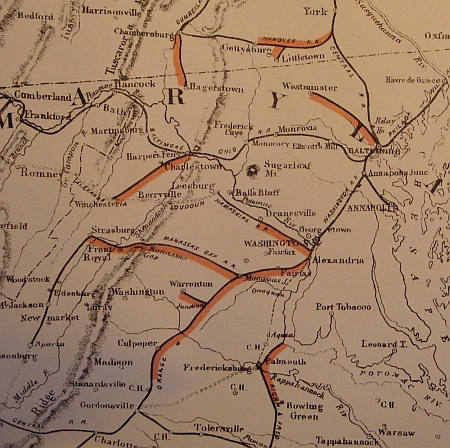
|
|
Portion of the Map of United States Military Rail Roads, Showing the Rail Roads operated during the War from 1862-1866 Under the Direction of Bvt. Brig. Gen. D.C. Mc.Callum, Director and General Manager, 1866, National Archives and Record Administration, Record Group 92, Entry 1529 [Note: Orange highlight indicates 4´-8 1/2″ gauge.] |
| ORIGINAL CONSTRUCTION |
|
The Orange and Alexandria Railroad, which originated in Alexandria, was constructed in sections beginning in Alexandria and building westward. Thomas C. Atkinson was the chief engineer responsible for construction of the railway and Albert H. Campbell, who laid out the location of the line between Accotink and the west bank of Bull Run, was an assistant engineer. In a May 1850 company report to the stockholders, the president and directors stated that the route of the railroad from Alexandria to about one mile west of Bull Run was finalized and that contractors were busy at the work of graduation and masonry. A contract was initially let on April 18, 1850 to Messrs. Eggleston, Mathews, Deckers, and McDonald for the 58-mile section of the railroad that included the bridge over Bull Run. [2] Wm. Eggleston & Co. was a New York firm that shipped their carts and tools from New York to Virginia. They expected to employ 2,000 workers for the construction and planned to construct houses for the accommodation of the laborers.[3] This company failed and discontinued work about June 10, 1850, causing considerable delay and cost to the project.[4] A new firm was selected to undertake the work.[5] By October 1851, the railway extended to Bull Run at the border between Fairfax and Prince William Counties. [6] |
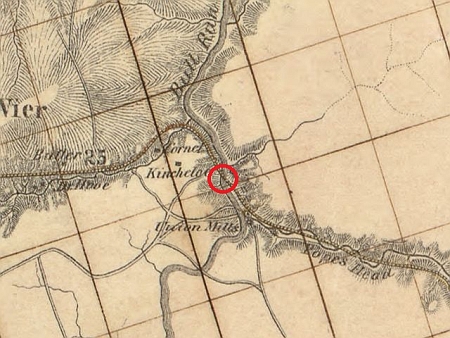
|
|
Location of the Bull Run Bridge as Shown on a Map and Profile of the Orange and Alexandria Rail Road, by August Faul, ca. 1850, Courtesy Library of Congress The Orange and Alexandria Railroad likely built a truss bridge across Bull Run. The following sketch, drawn in April 1862 by Edwin Forbes, depicts a destroyed railroad bridge at Bull Run. Only the stone abutments remained. |
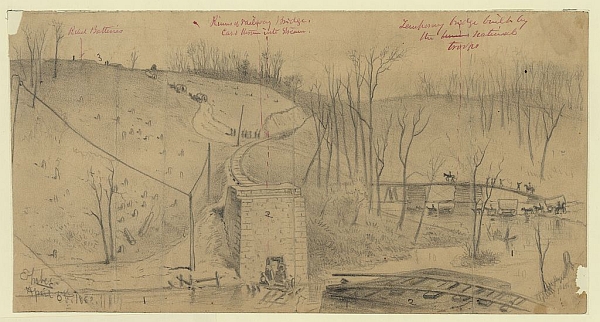
|
|
Sketch of Ruins of the Orange and Alexandria Railroad Bridge over Bull Run, by Edwin Forbes, April 1862, Courtesy Library of Congress. The sketch was drawn about a month after the Confederate army retreated from Centreville and Manassas at the start of the Peninsula Campaign. The bridge abutment shown in the sketch was a standard “U” abutment with a bridge seat at the top. In the following diagram of a “U” abutment from an 1857 book on railroad construction, the bridge seat is labeled B B.[7] 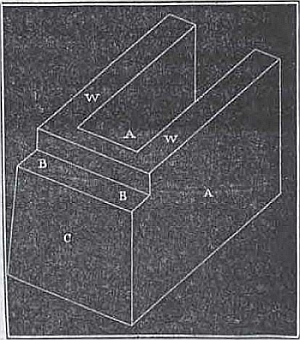
The abutment design suggests that the original bridge was a truss bridge. Wooden girders, on which the railroad ties were laid, would have extended across the stream from one abutment to another. Since girders were in tension, i.e., forces caused the girders to stretch, the vertical face of the bridge seat provided support to the ends of the girders to restrain the tension. “U” Abutment Detail, Handbook of Railroad Construction for the use of American Engineers, 1857, Courtesy Google Books |
| CIVIL WAR RAILROAD BRIDGE CONSTRUCTION AND REPAIR |
|
During the war, the United States Military Railroad Construction Corp was kept occupied repairing the railroad, adding sidings, and replacing bridges that were destroyed by Confederate troops and spring floods. Because the railroad was already constructed when the war began, the war-time work on the railroad in Fairfax County included making repairs where previously existing structures were destroyed. In some ways, this limited repair options since portions of the damaged structures often remained. A primary objective of the Construction Corp was to repair destroyed railways quickly so that supply lines, and the ability to quickly transport large numbers of soldiers, would not be interrupted. Due to the challenges associated with defending numerous railroad bridges from night-time raids, repair and replacement of bridges was frequent. As a result, quick construction time and simplicity of design were more important than durability for military bridges.[8] 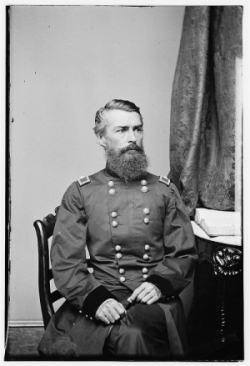
Hermann Haupt’s method for achieving quick repairs was to use designs that allowed for multiple teams to repair different sections of a bridge at one time. Simple designs enabled construction workers with little experience to build bridges of any span length. Standard sizes were used for various wood members in the bridge structure so that a worker could pick up a piece of lumber from a pile and have a size he needed.[9] Some wood members and structures were prepared in advance at the Alexandria yard; however, local materials were used whenever possible to reduce transportation time to the repair site. When using logs cut from nearby forests, the branches were removed, yet the wood was not cut square unless necessary in order to save labor time. [10] Gen. Hermann Haupt, Brady Studio, Civil War Era, Image Courtesy Library of Congress |
| BULL RUN BRIDGE |
|
The bridge over Bull Run was repaired and replaced numerous times during the war by the USMRR who gained control of the bridge in March 1862. In August 1862 following the Second Battle of Manassas, Haupt telegraphed President Lincoln the following: |
|
To President Lincoln Arrivals of our rail road men report that officers at Fairfax say that we have no troops beyond Bull run that there is no firing heard at Fairfax that the enemy appears to be moving towards Leesburg. Bull run Bridge is reconstructed except rails which I will not lay at present as we have no use for the track. I am not sending supplies to Fairfax but am bringing in the wounded as fast as possible. More wounded still coming in, about 1000 wounded there at this time. Large quantities of supplies go by wagon from Alexandria. All our cars and engines beyond Bull Run were destroyed by our own men. H. Haupt |
|
War-time photos of the various bridges exhibit an increasing sophistication and technological advancement over time. The earliest photo of the bridge in March 1863 shows construction of a trestle bridge. Haupt felt that this type of bridge was preferable when the structure was not likely to be carried away during floods, the elevation was not too great, and the material was within reach.[11] |
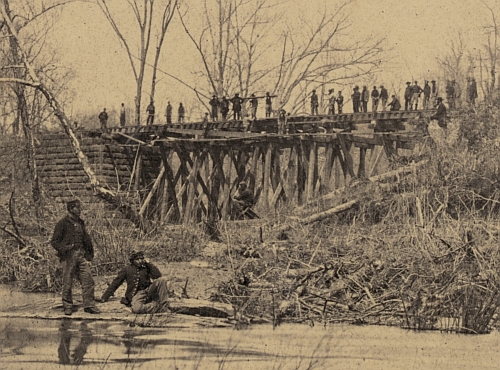
|
|
Repairing Bull Run Bridge, Construction Corps U. S. Military R Rds., March 1863, Andrew J. Russell, Photographer, Image Courtesy Library of Congress The following photograph shows a curve in the track where a couple of the trestles were knocked out of alignment. |
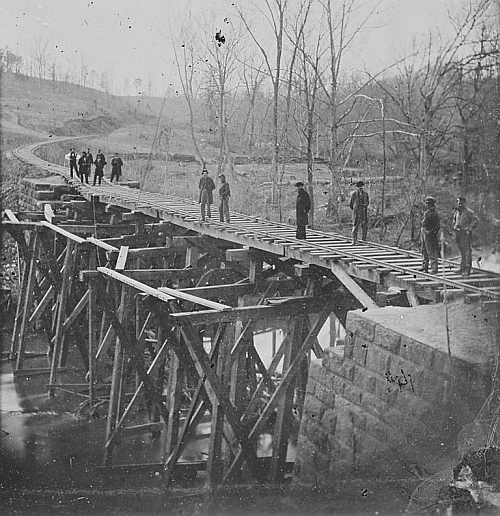
|
|
Bull Run Railroad Bridge, 1863, Matthew Brady Studio, Courtesy National Archives Andrew Russell, who was a photographer for the USMRR, captured photos of the Bull Run Bridge before and after a spring flood in 1863. |

|
|
Bull Run Trestle Bridge Before Freshet, April 1863, Andrew J. Russell, Photographer, Image Courtesy Library of Congress The newly-constructed Bull Run trestle bridge was damaged by a spring flood in April 1863. This bridge had seven supports. |
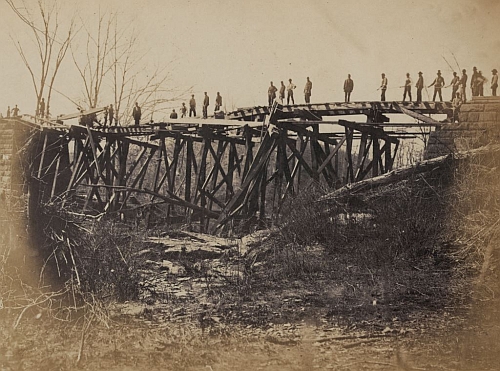
|
|
Bull Run Trestle After Freshet, April 1863, Andrew J. Russell, Photographer, Image Courtesy Library of Congress Workers with the USMRR Constuction Corps used ropes during the repair of the bridge. |
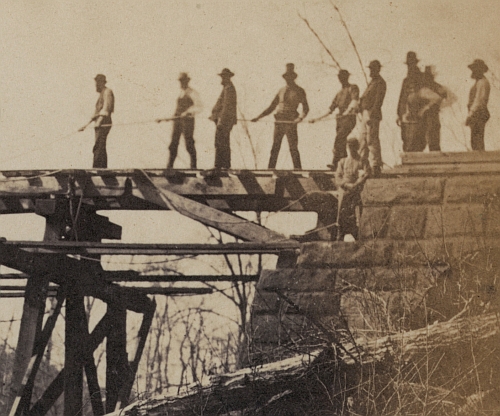
|
|
Close up of USMRR Construction Corps Repairing Bull Run Trestle Bridge after Freshet in April 1863, Andrew J. Russell, Photographer, Image Courtesy Library of Congress Andrew Russell took a photo of the first train to cross the bridge after the repairs were complete. Apparently the bridge was able to support the load of the train since there weren't any reports of the bridge failing. |
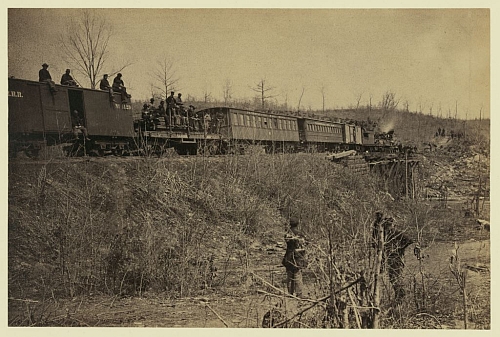
|
|
Frist Train Across Bull Run Trestle Bridge, Spring 1863, Andrew J. Russell, Photographer, Image Courtesy Library of Congress The bridge over Bull Run was repaired and replaced several
times in the spring of 1863. On April 22, 1863,
a Lattice Bridge was ordered to be loaded and sent to Bull Run.[12]
The bridge, seen below, appears to contain elements of a truss design that Haupt
developed prior to the war to improve the common lattice bridge that had a
tendency to twist. Haupt’s improvement consisted of vertical ties and inclined
braces.[13]
|
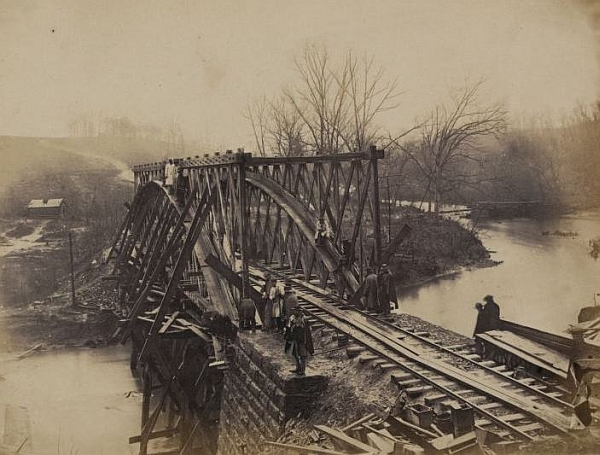
|
|
Lattice Truss Bridge Over Bull Run, April 1863, Andrew J. Russell, Photographer, Image Courtesy Library of Congress The advantage of a lattice truss bridge over a trestle bridge is that the lattice truss allowed heavier loads to cross the bridge. With the trestle bridge, the girder is in tension (i.e. it wants to expand outward). There aren’t any other members to counteract this force. With a truss bridge, the bottom chord is in tension and the top chord is in compression (i.e. wants to squeeze inward). The lattice work strengthens the bridge by balancing the tension and compression throughout the truss. The bridge also contained an arch that further strengthened the bridge by transferring loads directly to the abutments. The arch was constructed on site, probably so it could be custom built to fit the existing span. The lattice truss bridge installed in April 1863 was built over nine trestles as seen in the following photo. It was usual in bridge construction to support the structure on scaffolding, called false-works, until the bridge was self-sustaining. |

|
|
Lattice Truss Bridge Over Bull Run, April 1863, Andrew J. Russell, Photographer, Image Courtesy Library of Congress 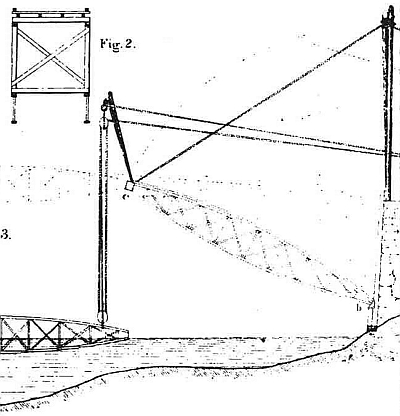
It would seem that the challenging part of this work was not construction of the truss bridge itself, which was built in Alexandria, but installing the bridge between the abutments. Hermann Haupt, in his 1864 book on military bridges, described maneuvers for raising trusses by using ropes, posts, capstans, and pulleys.Following is a portion of a plate from the book that depicts raising a truss.[14] Haupt’s Military Bridges, Plate 27, Image Courtesy Google Books The following photo shows poles and ropes for raising a truss similar to the image in Haupt’s book. |
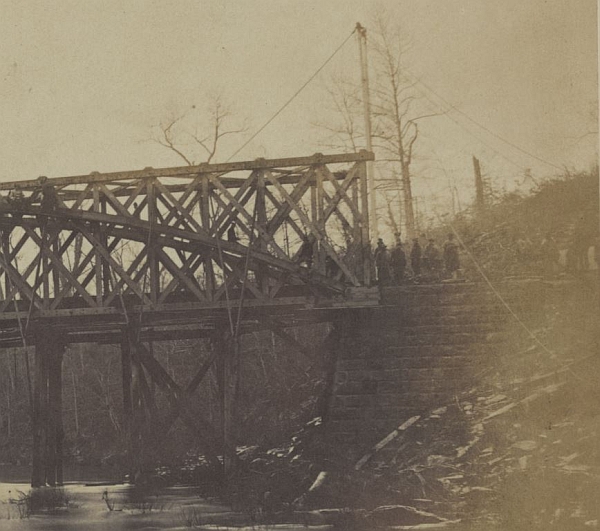
|
|
Lattice Truss Bridge Over Bull Run, April 1863, Andrew J. Russell, Photographer, Image Courtesy Library of Congress Once the truss was self-supporting, the false-works (scaffolding trestles) were removed. |

|
|
Military Bridge Haupt Truss, April 1863, Brady Studio, Image Courtesy National Archives and Record Administration . The USMRR Construction Corp was organized into various divisions. On July 30, 1863, G. W. Nagle was put in charge of the entire bridge force as Master Bridge Builder.[15] Other divisions chopped wood, built defenses, constructed sidings, and repaired rails. On August 5, 1863 Ada Anderson ordered J. R. Clough, Chief Construction Engineer to employ bridge men to make bridge defenses between Alexandria and Manassas, Block Houses, Stockades, etc. If necessary, he could apply to General Haupt for a guard to protect workmen from guerillas.[16] |
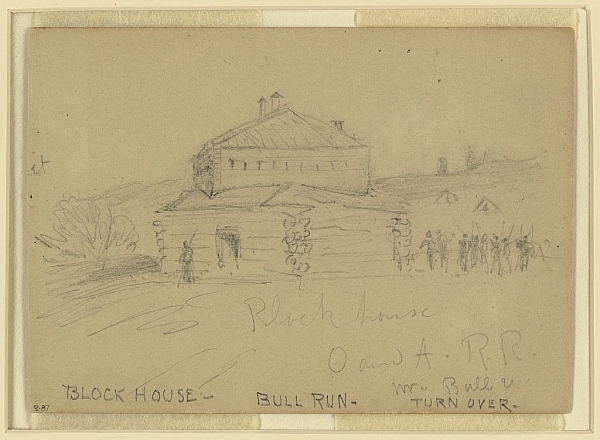
|
|
Blockhouse, Orange and Alexandria Railroad Near Bull Run, Alfred R. Waud, artist, Image Courtesy Library of Congress Occasionally other repairs and modifications were made to the bridge over Bull Run. On September 9, 1863, Ada Anderson, Chief Engineer of the USMRR at Alexandria ordered J. R. Clough, Construction Engineer, to raise the height of the Bull Run bridge, so altered as to give seventeen feet three inches in clear above the rail. At Bull Run the trusses should be straightened up and so braced as to prevent further moving from a vertical position.[17] The following photos were taken after the clearance height was raised. It is evident from of the photos that the top cross members were raised up on blocking and braced. |
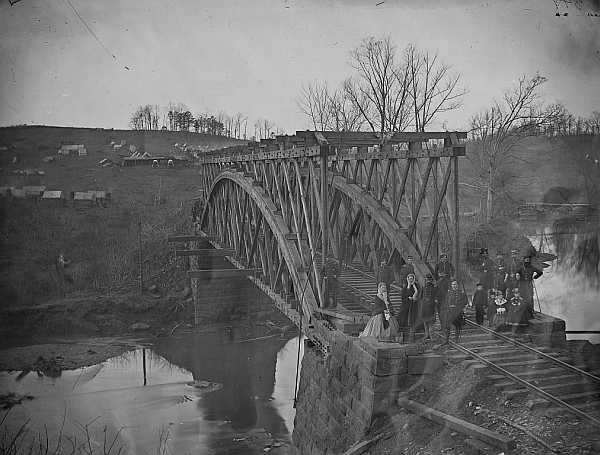
|
|
Bridge, Brady National Photographic Art Gallery, National Archives and Records Administration 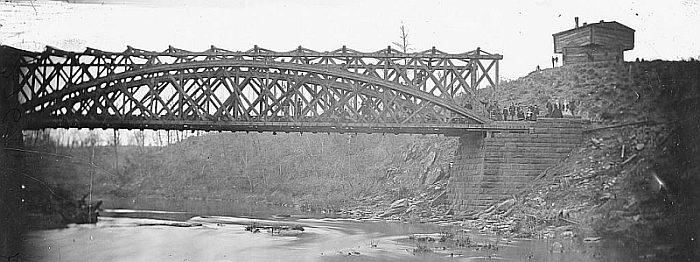
Blockhouse and Bridge Built by Engineers, Brady National Photographic Art Gallery, National Archives and Records Administration 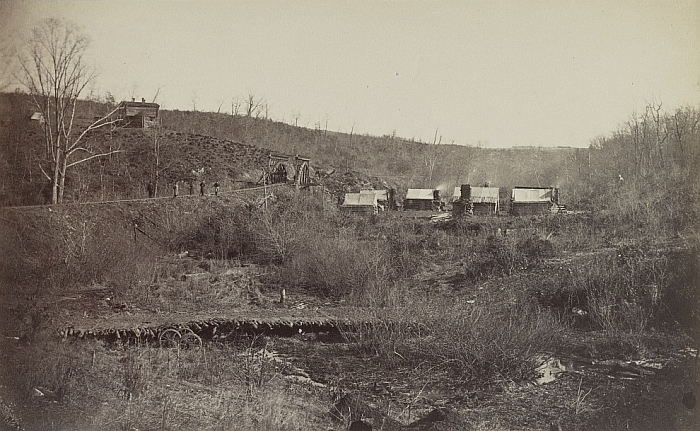
Bridge and Block House on Orange and Alexandria Rail Road near Bull Run, Image Courtesy Library of Congress |
| NATIONAL ARCHIVE RECORDS |
|
The National Archives and Records Administration stores the records of the United States Military Railroad. The Daily Journals of Events in the Office of the Chief Engineer and the Daily Journals of Work Performed by the Construction Corps were used to record activities and orders. The following items were listed in the daily journal pertaining to the bridge at Bull Run.[18] April 14, 1863 Bull Run Bridge completed at 12 M. Two engines crossed today. April 16, 1863 Bull Run Bridge carried away last night by freshet. April 18, 1863 Order Nagle again to rebuild Bull Run Bridge. April 19, 1863 Nagle and bridge force left for Bull Run Bridge at 6 a. m. April 20, 1863 Order Nagle to Alexandria from Bull Run with all his force. April 20, 1863 Tel. Gen. Heintzleman for guard for Construction Force beyond Bull Run. April 22, 1863Construction train went from Union Mills to Bealton today. Have Lattice Bridge loaded for Bull Run Bridge April 24, 1863 Bull Run Bridge Irons to be loaded ready to send out. April 25, 1863 Order Bull Run Truss Bridge sent to stream by 11 a.m. train. C. F. Nagle to make more train tests and report results. Roelop to have Arch Suspension Bolts welded to lengths as given by Nagle. Telegraph Co. McCallum for sixty feet three inch gas pipe for Bull Run. April 30, 1863 Order Farrands Gang of Carpenters from Bull Run Bridge. Order Nagle and all his force from Bull Run. May 6, 1863 Fanen and men left for Bull Run Bridge 11 a.m. to repair it. September 9, 1863 Ordered J. B. Clough to change height of Cameron run and Bull run bridges. September 11, 1863 Workmen commenced work to change height of Cameron run and Bull run bridges. October 12, 1863 Orders to evacuate O&A RR tonight. — measures taken accordingly. All construction and maintenance force and material ordered into Alexandria. January 30, 1864 Commenced Repairs on Bull Run Bridge April 10, 1864 Bull Run Bridge washed away entirely. April 11, 1864 Bull Run Bridge all right at 4 this P.M. May 5, 1864 The Bridge Corps of RR is now encamped at Burkes, ready for any emergency which may arise, from the burning of Bridges &c. by Rebel raiders. May 7, 1864 Union Mills still remains our front. May 12, 1864 Two trains were run to Rappahannock and two trains to Brisoe this afternoon. They went for the purpose of brining in the Troops and Pontoons that are lying at the respective stations. Genl. Grant having placed his Army beyond all communication from this Road, there is very little use of keeping it open – except to Union Mills which is the outpost of the Defenses of Washington. May 25, 1864 Received rumor that Accotink Bridge, Bull Run Bridge, Block House at Burkes and we fear all other structures on the Line of Road have been burned by Moseby’s gang. July 10, 1864 Our front is now Alexandria. [1] James J. Mapes, Ed., The American Repertory of Arts, Sciences, and Manufactures, Vol 1, W. A. Cox, Mechanics’ Institute, New York, 1840, p. 68. Hermann Haupt, of York Pennsylvania patented a bridge truss on December 27, 1839. Also, Edward Harold Mott, Between the Ocean and the Lakes: The Story of Erie, Ticker Publishing Co., New York, 1908, p. 434. Daniel McCallum invented an inflexible arch truss for bridges. [2] Board of Public Works, Annual Report of the Board of Public Works to the General Assembly of Virginia with the Accompanying Documents, 1850, pp. 93-99. [3] Alexandria Gazette, May 3, 1850, p. 2. [4] Alexandria Gazette, August 23, 1851, p. 2. [5] “Orange and Alexandria Railroad Company,” Alexandria Gazette, May 30, 1851 p.2. [6] “The Orange & Alexandria R. R.,” Alexandria Gazette, October 6, 1851, p. 2. [7] George L. Vose, Handbook of Railroad Construction for the use of American Engineers, Containing the Necessary Rules, Tables, and Formulae for the Location, Construction, Equipment, and Management of Railroads as Built in the United States,James Munroe and Company, Boston and Cambridge, 1857, p. 243, as viewed on Google Books. [8] Hermann Haupt, Military Bridges: With Suggestions of New Expedients and Constructions for Crossing Streams and Chasms. Including, Also, Designs for Trestle and Truss Bridges for Military Railroads, D. Van Nostrant, New York, 1864, p.8. [9] Hermann Haupt, Military Bridges: With Suggestions of New Expedients and Constructions for Crossing Streams and Chasms. Including, Also, Designs for Trestle and Truss Bridges for Military Railroads, D. Van Nostrant, New York, 1864, p.8. [10] Hermann Haupt, Military Bridges: With Suggestions of New Expedients and Constructions for Crossing Streams and Chasms. Including, Also, Designs for Trestle and Truss Bridges for Military Railroads, D. Van Nostrant, New York, 1864, p.9. [11] Hermann Haupt, Military Bridges: With Suggestions of New Expedients and Constructions for Crossing Streams and Chasms. Including, Also, Designs for Trestle and Truss Bridges for Military Railroads, D. Van Nostrant, New York, 1864, pp.8-9. [12] Daily Journals of Events in the Office of the Chief Engineer 2-1863 to 3-1864, National Archives and Record Administration, Record Group (RG) 92, Entry 1638, 22 Apr 1863. [13] George L. Vose, Handbook of Railroad Construction for the use of American Engineers, Containing the Necessary Rules, Tables, and Formulae for the Location, Construction, Equipment, and Management of Railroads as Built in the United States,James Munroe and Company, Boston and Cambridge, 1857, p. 158, as viewed on Google Books. [14] Hermann Haupt, Military Bridges: With Suggestions of New Expedients and Constructions for Crossing Streams and Chasms. Including, Also, Designs for Trestle and Truss Bridges for Military Railroads, D. Van Nostrant, New York, 1864, pp. 86-87. [15] A. Anderson, Order dated July 30, 1863, A. Anderson Press Letters, National Archives and Record Administration, Record Group 92, Entry 1588, p. 69. [16] A. Anderson, Memoranda for J. B. Clough, Construction Engineer, August 5, 1863, A. Anderson Press Letters, National Archives and Record Administration, Record Group 92, Entry 1588, p. 71. [17] A. Anderson, Letter to J. B. Clough, September 9, 1863, A. Anderson Press Letters, National Archives and Record Administration, Record Group 92, Entry 1588, p. 77. [18] Daily Journal of Events in the Office of the Chief Engineer 2-1863 to 3-1864, Record Group 92, Entry 1638; Daily Journals of Work Performed by the Construction Corps 4-1863 to 1-1864, Record Group 92, Entry 1943. |

| Home |
 |
| © Debbie Robison, unless otherwise noted. All rights reserved. |